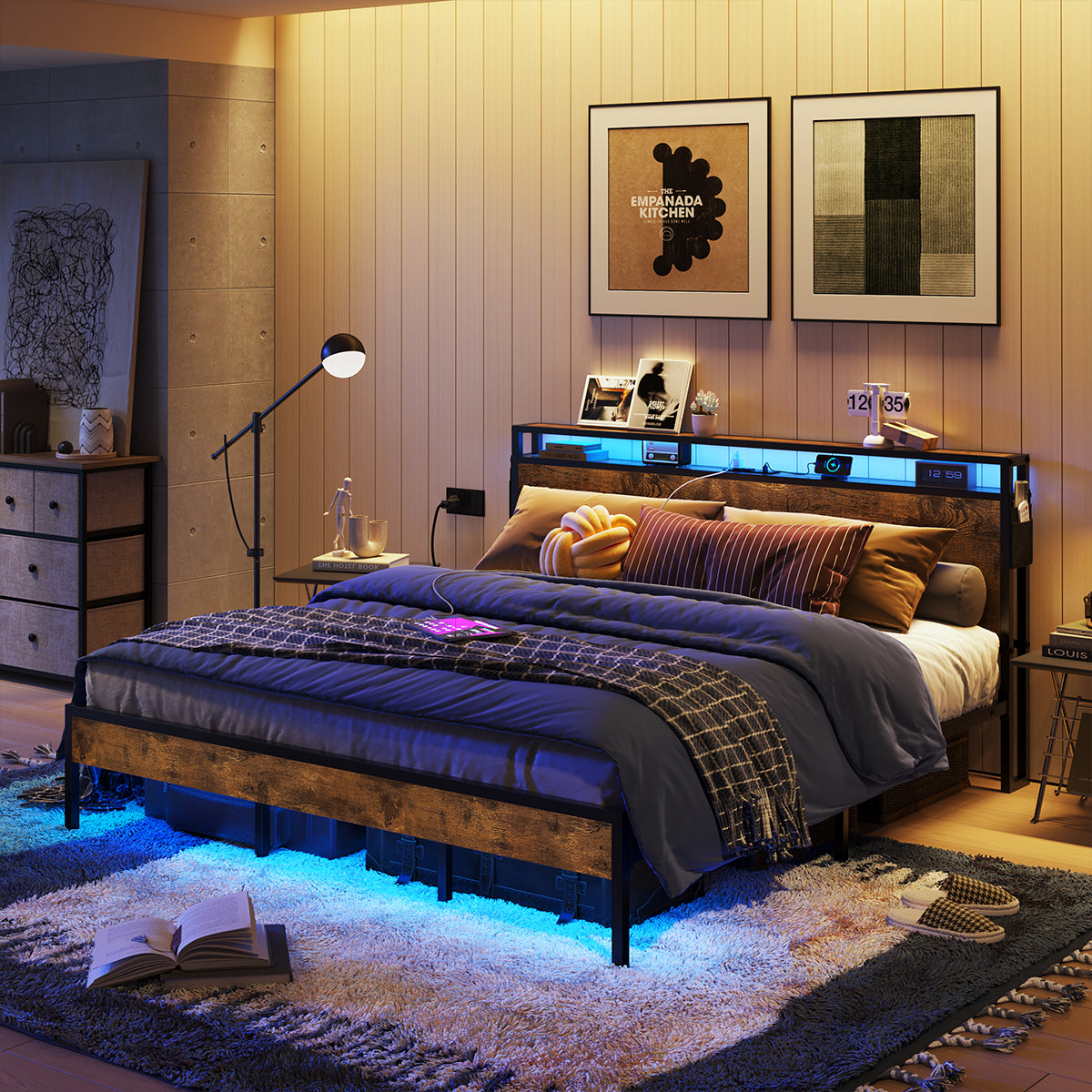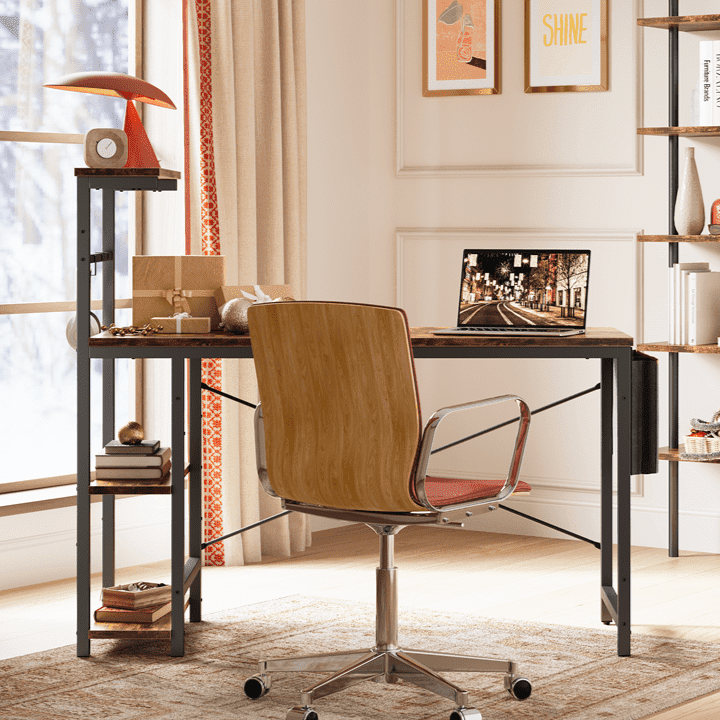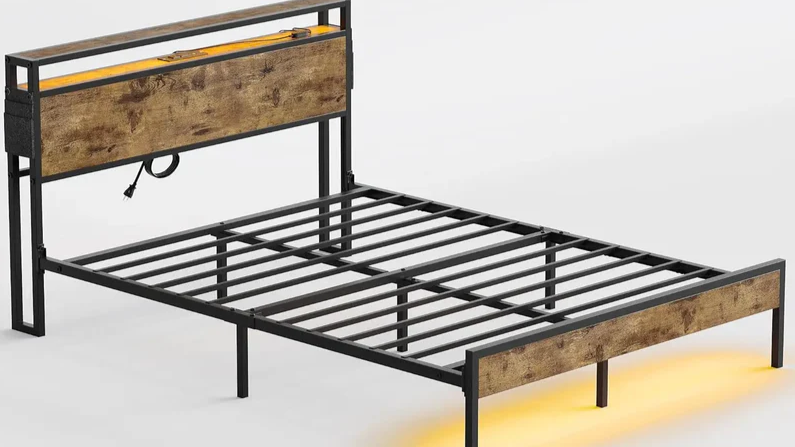Tired of the disruptive squeaks from your metal bed frame? You're not alone. We'll explore how to stop those annoying noises and ensure a peaceful sleep.
Why Does a Metal Bed Frame Make a Creaking Sound?
Friction Between Metal Components
As time goes by, the metal parts of your bed frame may start to rub against each other, generating friction and resulting in those annoying creaking noises you hear.
Loose Joints or Bolts
If the bolts or joints holding your bed frame together aren't tightened properly, they can gradually become loose over time. When weight is applied to the frame, this looseness can cause movement and noise.
Worn-out Parts
Wear and tear is inevitable, and your bed frame isn't exempt. Whether it's worn-down metal surfaces or damaged components, these signs of age can contribute to the creaking sounds you're experiencing as you use your bed.
Uneven Weight Distribution
Ever notice that certain spots on your bed seem to creak more than others? Uneven weight distribution might be the culprit. When you sit or lie down in specific areas of the bed, it can put extra stress on those parts of the frame, leading to creaks.
Lack of Lubrication
Just like any mechanical system, metal-on-metal contact requires lubrication to function smoothly. If your bed frame's metal parts aren't adequately lubricated, especially in areas where they rub against each other, it can escalate friction levels and result in more pronounced creaking noises.
The Bed Frame Legs Become Uneven
Uneven bed frame legs can result in annoying squeaks and creaks.
The Metal Frame Rubs on the Floor
Friction between the metal frame and the floor is a common cause of squeaking in metal bed frames.
How to Fix a Squeaky Metal Bed Frame?

Silicone-Based Lubricant Application
If you notice creaking coming from the bed's headboard, apply a thin layer of silicone-based lubricant to the joints where metal meets metal. This will reduce friction between the components and eliminate the noise.
Tightening Loose Bolts
When inspecting your bed frame, you discover that the bolts securing the side rails are slightly loose. Use a wrench to tighten them until they are snug against the frame. This will prevent any movement that could cause creaking.
Replacement of Damaged Slats
After removing the mattress, you notice that one of the metal slats supporting the bed's foundation is bent and no longer providing adequate support. Replace the damaged slat with a new one to restore stability and eliminate the creaking.
Adjusting Mattress Position for Even Weight Distribution
You observe that the creaking intensifies when you sit on one corner of the mattress. To address this, rotate the mattress 180 degrees and reposition it so that the weight is evenly distributed across the frame. Consider adding additional slats under the heavily loaded area for extra support.
Application of Furniture Wax to Drawer Slides and Hinges
You hear creaking sounds when opening and closing the bed's storage drawers. Apply a generous amount of furniture wax to the drawer slides and hinges to ensure smooth operation. This will eliminate the friction causing the creaking noise.
Consider employing anti-slip pads
Preventing a metal bed frame from squeaking with anti-slip pads involves strategically placing adhesive rubber, felt, silicone, or rubber gripper pads beneath the legs of the frame. These pads act as a buffer between the metal structure and the floor, effectively reducing friction and minimizing noise. It's crucial to choose pads of appropriate size and ensure they are firmly attached to the legs for optimal performance in dampening vibrations and preventing squeaks.
Try adjusting the legs
Uneven bed frame legs can lead to squeaking. You can address this by adjusting the legs directly and checking with a level to ensure proper alignment. If the legs are not adjustable, you can use shims, cardboard pieces, or folded clothes to support the shorter legs until they are level with the others.
Purchase a High-Quality, Sturdy, and Silent Bed Frame
When the squeaking of the bed frame becomes excessively loud, persistent, or disruptive, it may indicate structural issues or wear beyond normal levels, suggesting that the bed frame may no longer be suitable for use. Additionally, if attempts to fix the squeaking fail to produce results or if the bed frame shows signs of significant damage or instability, it may be time to consider replacing it for safety and comfort reasons. We suggest purchasing a bed frame designed with metal slats and heavy-duty steel support legs. The bed frame comes with soundproof strips to help reduce noise, providing you with a quiet sleeping experience.
How to Identify if Your Metal Bed Frame is Creaking Due to the Mentioned Reasons

Friction Between Metal Components
Listen closely when you sit or move on the bed. If you hear squeaks under pressure, it might be due to metal parts rubbing against each other. Check for any wear marks or scratches on the bed frame that could indicate metal-on-metal contact.
Loose Joints or Bolts
Give your bed frame a gentle shake. If you notice any wobbling or shifting, loose joints or bolts could be the culprit. Take a closer look at the bolts and joints to see if they're visibly loose or worn out.
Worn-out Parts
Examine the bed frame for signs of wear or damage, such as bent slats or sagging areas. These could indicate worn-out components contributing to the creaks.
Uneven Weight Distribution
Pay attention to where the creaks are most prominent. If certain spots on the bed seem to creak more than others, it could be a sign of uneven weight distribution. Also, notice if the creaking gets worse when pressure is applied to specific areas of the mattress.
Lack of Lubrication
Look for areas of the bed frame with visible signs of friction, like rough surfaces or friction marks. Dry or squeaky spots could indicate a lack of lubrication.
The Bed Frame Legs Become Uneven
To identify uneven bed frame legs, check for wobbling, visually inspect leg height and angle, and listen for unusual sounds like creaking during movement.
The Metal Frame Rubs on the Floor
To check if the metal frame rubs on the floor, inspect for scrape marks underneath, listen for squeaking sounds, and look for floor scratches caused by metal friction.
What Causes a New Bed to Squeak? What Can Be Done About It?

New beds may start squeaking for the following reasons:
- Loose Bolts and Joints: newly assembled beds may have bolts and joints that aren’t fully tightened.
- Friction Between Components: metal or wood parts rubbing together can create noise.
- Improper Assembly: misalignment of parts during assembly can cause stress and squeaking.
- New Materials Settling: wood and other materials may shift as they settle.
- Mattress Support: shifting of the mattress or box spring can cause friction and noise.
To address the above issues, we recommend the following steps:
- Tighten Bolts and Screws: Ensure all connections are secure.
- Lubricate Moving Parts: Use a silicone-based lubricant on friction points.
- Check Assembly: Verify proper assembly and realign if necessary.
- Add Padding: Place felt pads or rubber washers between rubbing parts.
- Adjust the Mattress: Ensure the mattress and box spring are correctly positioned and stable.
Analyzing the Sources of Squeaking from Various Types of Metal Bed Frames—Do They Have Common Origins?

Types of Metal for Bed Frames
- Steel Bed Frames: Sturdy frames made from steel, known for their durability and sleek design. Easy to assemble and resistant to bending. Solid and quiet, it emits minimal noise. Some bed frames are supported by a combination of 14 metal slats and 11 heavy-duty steel support legs, with a maximum weight capacity of up to 1500 lbs. This product is highly popular and known for its stability without squeaking noises.
- Iron Bed Frames: Classic frames crafted from wrought or cast iron, offering timeless elegance and robust support. Robust and resonant, it produces a deep sound but may develop creaks over time.
- Aluminum Bed Frames: Lightweight frames with a modern look, constructed from corrosion-resistant aluminum. Light and subtle, it creates a metallic sound.
- Brass Bed Frames: Luxurious frames made from brass-plated metal or solid brass, adding warmth and sophistication to any bedroom. It resonates with a pleasing tone but may develop creaks with age.
- Wrought Iron Bed Frames: Artfully designed frames forged by hand, featuring intricate detailing and lasting durability. It emits a deep sound similar to iron, with the potential for squeaks over time.
Types Catering to Various Styles, Functionalities, and Space Requirements
- Platform Bed Frames typically produce minimal noise due to their simple and sturdy construction. The absence of a box spring reduces the potential for creaking or squeaking sounds.
- Adjustable Bed Frames may make noise when the motors adjust the position, but modern models often have quiet mechanisms to minimize disruption.
- Canopy Bed Frames are generally quiet, as they consist of sturdy vertical posts and a canopy frame that does not move or produce significant noise during normal use.
- Sleigh Bed Frames, with their solid construction and curved headboard and footboard, tend to be quiet during use. However, over time, wood joints may loosen, potentially leading to minor creaking sounds.
- Daybed Frames, if sturdy and made of wood or metal, usually make minimal noise during use, which rarely disturbs sleep.
- Folding Bed Frames may produce noise when being set up or folded down due to the hinges and moving parts.
- Trundle Bed Frame may produce noise when the lower mattress is pulled out or pushed back in due to the movement of the casters or wheels. However, the noise is usually minimal and temporary.
- Loft Bed Frames are generally quiet, and made of solid materials without moving parts. But noise may arise from items moved beneath them.
- Bunk Bed Frames may creak or squeak when the top bunk is used, but with proper assembly and maintenance, noise is usually minimal.
- Four-Poster Bed Frames are generally quiet, with solid columns and a canopy frame. However, slight movement over time may cause noise.
Conclusion
Dealing with a squeaky metal bed frame doesn't have to be a challenge. By understanding the underlying causes and implementing the suggested solutions, you can effectively eliminate squeaks and enjoy a peaceful sleep environment. Don't let creaking noises disrupt your rest—take action to fix your squeaky metal bed frame today!






